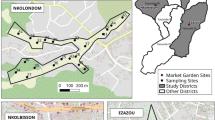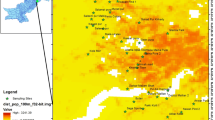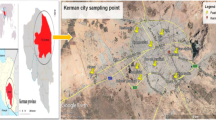Abstract
The purpose of the present study was to evaluate and zoning the environmental hazards of heavy metals in the soil using the Nemerow integrated pollution index in vineyards (vineyards) of Malayer city. In this study, after consecutive visits to the study area and reviewing the map of the area, sampling operations were performed in January 2019. Soil sampling was performed based on a systematic random method. A total of 286 samples were collected from topsoil (depth 0 to 20 cm). Of these, 157 samples were located in agricultural lands (gardens and agricultural land) and 129 samples in natural areas (pastures and barren lands). The samples were analyzed by high-resolution continuum source atomic absorption spectrometry (HR-CS AAS) and using the flame method. The average concentrations of Cu, Mn, Zn, Cr, As, Ni and Hg are 87.86, 597, 109, 67.12, 47.1, 84.32, and 0.344 mg/kg, respectively. These values are lower than the NIPI index values for these metals. The results showed that there is a positive and significant correlation between Cu and Mn, Cu and zinc, Cu, and As as well as As and Ni. There is also a significant negative correlation between Cu and Hg, As and the electrical conductivity (EC) as well as As and Mn. At present, these soils are not at serious risk of soil contamination with heavy metals.




Similar content being viewed by others
Notes
Root mean square error.
Mean absoluter error.
Mean basis error.
References
Abrahim GMS, Parker RJ (2008) Assessment of heavy metal enrichment factors and the degree of contamination in marine sediments from Tamaki Estuary, Auckland, New Zealand. Environ Monit Assess 136:227–238. https://doi.org/10.1007/s10661-007-9678-2
Atafar Z, Mesdaghinia A, Nouri J et al (2010) Effect of fertilizer application on soil heavy metal concentration. Environ Monit Assess 160:83–89. https://doi.org/10.1007/s10661-008-0659-x
Barringer JL, Szabo Z, Reilly PA, Riskin ML (2013) Variable contributions of mercury from groundwater to a first-order urban coastal Plain Stream in New Jersey, USA. Water Air Soil Pollut 224:1475. https://doi.org/10.1007/s11270-013-1475-7
Bermejo-Barrera P, Barciela-Alonso C, Aboal-Somoza M, Bermejo- Barrera A (1994) Slurry sampling for the determination of lead in marine sediments by electro thermal atomic absorption spectrometry using palladium–magnesium nitrate as chemical modifier. J Anal At Spectrom 9:469–475. https://doi.org/10.1039/JA9940900469
Bowen HJM (1979) Environmental chemistry of the element. Academic Press, London, p 217
Canadian Ministry of the Environment (CME). (2009). Soil, ground water and sediment standards for use under part XV.1 of the Environmental Protection Act
Carballeira A, Carral E, Puente X, Villares R (2000) Regional scale monitoring of coastal contamination nutrients and heavy metals in estuarine sediments and organisms on the coast of Galicia (Northwest Spain). Int J Environ Pollut 13:534–572. https://doi.org/10.1504/IJEP.2000.002333
Chunfa W, Yongming L, Limin Z (2010) Variability of copper availability in paddy fields in relation to selected soil properties in southeast China. Geoderma 156(3–4):200–206. https://doi.org/10.1016/j.geoderma.2010.02.018
Dankoub Z, Ayoubi S, Khademi H, Lu SG (2012) Spatial distribution of magnetic properties and selected heavy metals in calcareous soils as affected by land use in the Isfahan region. Central Iran Pedosphere 22(1):33–47. https://doi.org/10.1016/S1002-0160(11)60189-6
European Environmental Agency (EEA), (2007). Progress in management of contaminated sites (CSI 015/LSI 003), https://www.eea.europa.eu/data-and-maps/indicators
Environment Protection Authority of Australia (2012). Classification and management of contaminated soil for disposal. Information Bulletin 105. Hobart, TAS 7001 Australia
Environmental Protection Ministry of China (EPMC). (2015). Standards of soil environmental quality of agricultural land. Huangbanhang 69: Office of Environmental Protection Ministry of China, Beijing, China
Farajzadeh S, Khaleghi MR (2020) Evaluation of the efficiency of the rainfall simulator to achieve a regional model of erosion (case study: toroq watershed in the east north of Iran). Acta Geophys 68:1477–1488. https://doi.org/10.1007/s11600-020-00487-0
Ghasemi H (2013) Geochemical and environmental assessment of the heavy metals in the soils derived from the gorgan schists. Geosci 22(86):35–46
Gholami V, Aghagoli H, Kalteh AM (2015) Modeling sanitary boundaries of drinking water wells on the Caspian Sea southern coasts. Iran Environ Earth Sci 74(4):2981–2990
Gholami V, Khaleghi MR, Sebghati M (2017) A method of groundwater quality assessment based on fuzzy network-CANFIS and geographic information system (GIS). Appl Water Sci 7(7):3633–3647
Gholami V, Khaleghi MR, Salimi ET (2020) Groundwater quality modeling using self-organizing map (SOM) and geographic information system (GIS) on the Caspian southern coasts. J Mt Sci 17(7):1724–1734
Hakanson L (1980) An ecological risk index for aquatic pollution control, a sedimentological approach. Water Res 975:50–56
He Z, Shentu J, Yang X, Baligar VC, Zhang T, Stoffella PJ (2015) Heavy metal contamination of soils: sources, indicators, and assessment. J Environ Indic 9:17–18
Ikem A, Campbell M, Nyirakabibi I, Garth J (2008) Baseline concentrations of trace elements in residential soils from Southeastern Missouri. Environ. Monit. 140:69–81. https://doi.org/10.1007/s10661-007-9848-2
Khaleghi MR, Varvani J (2018) Simulation of relationship between river discharge and sediment yield in the semi-arid river watersheds. Acta Geophys 66(1):109–119
Lemly AD, Richardson CJ (1997) Guidelines for risk assessment in wetlands. Environ Monit Assess 47:117–134. https://doi.org/10.1023/A:1005742403549
Li Z, Ma Z, Kuijp TJ, Yuan Z, Huang LA (2014) Review of soil heavy metal pollution from mines in China: pollution and health risk assessment. Sci Total Environ 468–469:843–853. https://doi.org/10.1016/j.scitotenv.2013.08.090
Loska K, Wiechuła D, Korus I (2004) Metal contamination of farming soils affected by industry. Environ Int 30(2):159–165. https://doi.org/10.1016/S0160-4120(03)00157-0
Ma L, Yang Z, Li L, Wang L (2016) Source identification and risk assessment of heavy metal contaminations in urban soils of Changsha, a mine-impacted city in Southern China. Environ Sci Pollut Res 23(17):17058–17066. https://doi.org/10.1007/s11356-016-6890-z
Mansoorfar K (2013) Statistical methods. Tehran Univ, Press, p 412p
Mico C, Recatala L, Peris M, Sanchez J (2006) Assessing heavy metal sources in agricultural soils of an European Mediterranean area by multivariate analysis. Chemosphere 65(5):863–872. https://doi.org/10.1016/j.chemosphere.2006.03.016
Mostert MMR, Ayoko GA, Kokot S (2010) Application of chemometrics to analysis of soil pollutants. Trend Anal Chem 29(5):430–445. https://doi.org/10.1016/j.trac.2010.02.009
Nendza M (2002) Inventory of marine biotest methods for evaluation of dredged material and sediments. Chemosphere 48(8):865–883. https://doi.org/10.1016/S0045-6535(02)00003-6
Pourkhabbaz HR, Javanmardi S, Yusefnia H, Eslami M, Makrouni S, Aghdar H (2016) Environmental evaluation of heavy metals contamination in soils around the cement factory in behbahan city. J Geogr Environ Plan 27(3):87–106
Qishlaqi A, Moore F, Forghani G (2009) Characterization of metal pollution in soils under two landuse patterns in the Angouran region, NW Iran; a study based on multivariate data analysis. J Hazard Mater 172(1):374–384. https://doi.org/10.1016/j.jhazmat.2009.07.024
Rapant S, Bodis D, Vrana K, Cveckova V, Kordik J, Krcmova J, Slaninka I (2009) Geochemical atlas of Slovakia and example of its applications to environmental problems. Environ Geol 57(1):99–110
Ravankhah N, Mirzaei R, Masoum S (2015) Evaluation of geoaccumulation index contamination factor and principal component analysis for estimating soil contamination. Iran J Health Environ 8(3):345–356
Sabadell JE, Axtmann RC (1975) Heavy metal contamination from geothermal sources. Environ Health Perspect 12:1–7. https://doi.org/10.1289/ehp.75121
Samadi A, Majidi A (2010) Norms establishment of the Diagnosis and Recommendation Intergrated System (DRIS) and comparison with DOP approach for nutritional diagnosis of seedless grape (Sultana, cv) in Western Azarbaijan Province, Iran. Iran J Soil Res 24(2):89–106
Shahbazi A, Safianian A, Mir Ghafari N, Ein Ghalaii MR (2012) Evaluation soil heavy metal contamination using by contamination factor, geoaccumulation and comprehensive pollution factor indices (Case study: Nahavand). Environ dev J 5:31–38 ((in Persian))
Solgi E, Parmah J (2015) Analysis and assessment of nickel and chromium pollution in soils around Baghejar Chromite Mine of Sabzevar Ophiolite Belt, Northeastern Iran. Trans Nonferrous Met Soc 25(7):2380–2387. https://doi.org/10.1016/S1003-6326(15)63853-5
Solgi I, Solgi M (2016) Investigating of heavy metals concentration Vineyard soils in the agricultural ecosystems of Malayer. J Plant Ecosys Conserv 3(7):99–111
Suter GW (2007) Ecological Risk Assessment, 2nd edn. CRC Press. Taylor & Francis Group, Boca Raton, Fla, p 680
Tafazoli M, Hojjati SM, Biparva P, Kooch Y, Lamersdorf N (2017) Reduction of soil heavy metal bioavailability by nanoparticles and cellulosic wastes improved the biomass of tree seedlings. J Plant Nutr Soil Sci 180(6):683–693. https://doi.org/10.1002/jpln.201700204
Tahsini H, Gavilian H (2016) Assessment risk food of heavy metals (cadmium, lead, zinc and copper) from the consumed crops have been distributed in Sanandaj. Zanko J Med Sci 17(54):62–72
Topcuoğlu B (2015) Determination and evaluation of heavy metal pollution in greenhouse regions of Antalya. Int Conf on Chemical, Metal and Environ Engin, Istanbul 3–4:287–295
Toselli M, Schiatti P, Ara D, Bertacchini A, Quartieri M (2009) The accumulation of copper in soils of the Italian region Emilia-Romagna. Plant soil Environ 55(2):74–79
Tuncer GT, Tuncel SG, Tuncel G, Balkas TI (1993) Metal pollution in the golden horn, Turkey-contribution of natural and anthropogenic components since 1913. Water Sci Technol 28:50–64. https://doi.org/10.2166/wst.1993.0604
United States Environmental Protection Agency (US EPA) (2002). Supplemental guidance for developing soil screening levels for superfund sites. Office of Solid Waste and Emergency Response, Washington, D.C. https://www.epa.gov/superfund/health/conmedia/soil/index.htm
United States Environmental Protection Agency (US EPA), (2004). Cleaning up the Nation's Hazardous Wastes Sites. https://nepis.epa.gov/Exe/ZyNET.exe/30006II3.TXT
Varvani J, Khaleghi MR (2019) A performance evaluation of neuro-fuzzy and regression methods in estimation of sediment load of selective rivers. Acta Geophys 67(1):205–214
Wei B, Yang L (2010) A review of heavy metal contaminations in urban soils, urban road dusts and agricultural soils from China. Microchem Journal 94(2):99–107. https://doi.org/10.1016/j.microc.2009.09.014
Zhang J, Liu CL (2002) Riverine composition and estuarine geochemistry of particulate metals in China—weathering features, anthropogenic impact and chemical fluxes. Estuar Coast Shelf Sci 54(6):1051–1070. https://doi.org/10.1006/ecss.2001.0879
Author information
Authors and Affiliations
Corresponding author
Additional information
Communicated by Savka Dineva, PhD (CO-EDITOR-IN-CHIEF)/Stelios Stoulos (ASSOCIATE EDITOR).
Rights and permissions
About this article
Cite this article
Yari, A.A., Varvani, J. & Zare, R. Assessment and zoning of environmental hazard of heavy metals using the Nemerow integrated pollution index in the vineyards of Malayer city. Acta Geophys. 69, 149–159 (2021). https://doi.org/10.1007/s11600-020-00514-0
Received:
Accepted:
Published:
Issue Date:
DOI: https://doi.org/10.1007/s11600-020-00514-0




